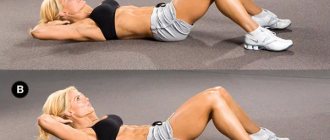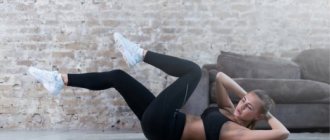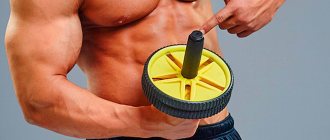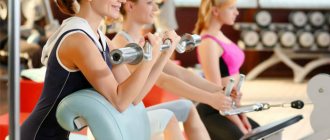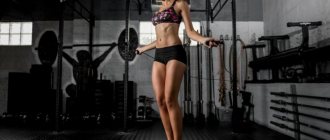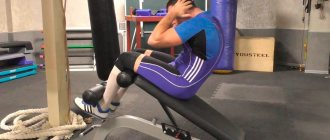Imagine that after many months of hard training, a significant reduction in the percentage of subcutaneous fat, you look at your abs and think: “Wait a minute - why are my abs crooked?” If your abs don't look like those of a fitness model, then first, calm down - this is normal. In fact, if you go to a bodybuilding competition, you will notice that a lot of guys and girls have asymmetry in their abs. From this article you will learn what are the three main reasons for this phenomenon and how to fix it.
Six facts about the abdominal muscles
First, I would like to remind you that absolutely every person has six-pack abs, even if they don’t train. However, they become noticeable only with a low percentage of subcutaneous fat deposits. It is quite obvious that in a person involved in sports they will be more noticeable. Now let's look at the basic facts regarding the abdominal muscles.
- Active abdominal training will not help you lose belly fat.
Often people start going to the gym before the beach season and actively work out their abs, hoping to get rid of belly fat. However, this is completely pointless, since lipolysis processes cannot be targeted. If you want to get rid of excess weight, then deadlifts or squats will be more useful in this regard. - The press does not have an upper and lower section.
Sometimes on specialized web resources you can find exercises aimed at pumping the upper and lower abdominal sections. However, there are no such concepts in anatomy, because the abs are one muscle, as we said at the beginning of the article. Thus, any movement aimed at strengthening the rectus abdominis muscle allows you to work it along its entire length. - The number of repetitions is not of fundamental importance.
For the development of the abs, the most important thing is the time that the muscle was under load. For example, when performing hanging leg raises, pause for a couple of counts at the heaviest point of the trajectory. A dozen such repetitions will be more effective compared to two dozen quick ones. It can be recommended to work to failure, in which, even with all the desire, it is no longer possible to perform at least one repetition. On average, this requires performing from 15 to 25 repetitions. - There is no need to raise straight legs and body.
The abdominal muscles can contract as much as possible when the back is rounded and the chin is pressed toward the chest. When performing all types of abdominal crunches, try to curl up into a ball. The knee joints can be slightly bent, and it is better to lift the pelvis rather than the legs. In this case, part of the load will not transfer to the quadriceps and hip flexor muscles. You should also remember that not all exercises for the abdominal muscles are safe, but more on that below. - A flat stomach and strong abs
are not the same thing. The transverse muscle is responsible for the ability to retract the abdomen, which is also worth pumping. There is one very effective exercise for this - “vacuum”. - You cannot strengthen your abdominal muscles and burn fat at the same time.
Actually, this applies to training any muscle group, because fat burning is a catabolic process that is possible with an energy deficiency. The growth of muscle mass, in turn, is an anabolic process and you will need a lot of energy to make your muscles increase in size.
Get started with font layout in InDesign
Level up or level out? In this guide, we'll look at common alignment options in typography and show you how to use them for best results.
Typesetting alignments depend on two main factors: layout and readability. For readable copy of, say, a few paragraphs, there are a few well-established rules to follow if you want people to get your message.
Let's look at some options and scenarios that define their use.
Align to width - what's the difference?
There are two general terms for what we are discussing:
- When text is justified, each line of continuous text returns to one side of the margin.
- Text alignment causes the spaces between words or individual letters to expand or contract to fill margins from edge to edge.
Looking at these terms, it's easy to see why people change them often, but technically they're not the same thing. They also lead to colloquialisms like "justified by force," which is redundant.
So, when we align text to the left, we call it left-aligned . For the center - Center-Aligned. What about the right side? That's right, we call it right-aligned .
In Adobe InDesign, known for its publication layout capabilities, these options can be found in the Paragraph window. Window > Type and Tables > Paragraph or Command + Option + T. With the text selected, you can change the justification or justification here.
When to align text
- Align Left —Use for most copies. In Western languages, we read from left to right, so a constant left edge helps us scan and understand sentences quickly and efficiently.
- Align Center - Use for headings and subheadings, such as supporting copy that is a paragraph or shorter.
- Align Right - Use for titles that are just a few words. Aligning longer pieces of text to the right can get boring, so use it sparingly for anything other than a full sentence.
When to align text
Grounded font was common for newspapers in the past—an artifact of a time when copy was physically composed of blocks of letters. Using text width today is a subjective choice. There are certain uses in design and aesthetics, but this can affect readability in more labor-intensive cases due to uneven spacing and disrupted visual rhythm of words.
You'll still see large blocks of justified text in some magazines and books (and, of course, newspapers). Notice how the negative space creates Rivers (when your eyes connect spaces in a way that distracts from the information) and scattered spaces because the text is forced to fill in the margins.
Rivers are a distraction and unnecessary. This is why it is best to use left alignment for paragraphs of text.
Additional terms and definitions
Align and justify are just the basics of text layout. Here are a few more text and layout concepts you might hear or read about.
Rag - Describes text aligned to one side. "Rag on the right" refers to the text Left Aligned and Unaligned. It was a convenient term in early advertising when justified copy—newspaper style—was still common. It's good design practice to manipulate shapes made with broken type. A soft return can be used to prevent edges from detracting from the flow and appearance of a paragraph. Not sure what a soft return is? Keep reading.
Hard return - When the typesetter presses the Enter/Return , a new paragraph begins. Use this to create a style break or activate certain style-based settings, such as preset spacing after a paragraph or leading settings.
Soft return - When a typesetter holds down the Shift , then presses the Enter/Return , it causes a line break but remains within the paragraph, keeping the leading and style rules intact.
Widows - In continuous text spanning several pages or columns, Widow is a word or sentence carried over from the previous page or column.
Orphans - The same, but on the contrary. An orphan is a line of text that starts at the bottom of a page or column and the rest of the paragraph ends on the next page/column.
Widows and orphans are also used to describe individual words or fragments when they are separated from their paragraph or sentence. Generally speaking, the orphan is at the beginning and the widow is at the end.
Wrap - In InDesign, turn Wrap by selecting the checkbox in the lower left corner of the Paragraph . You can also change the hyphenation settings. I usually just turn it off, but for large amounts of text they can come in handy. In this case, I installed them sparsely to improve the appearance of the copy. If necessary, I can install the transfer manually or refuse the settings.
Hyphenation settings are located in the “Paragraph” window. Click the hamburger menu in the upper right corner and select Transfers... .
Get amazing royalty-free photos, pictures and images.
Start now
Keep reading for more tutorials and design guides:
.
Why did the cubes appear only in the upper abdomen?
There may be two reasons:
- Too thick fold of subcutaneous fat that covers the lower part of the abs.
- Genetically determined form of abs.
Subcutaneous fat content can be determined using a test. If he shows that the thickness of the fold on the abdomen is about 10 mm, for the sake of the long-awaited cubes you will have to undergo drying. If there is almost no fat in the lower abdomen, you will not be able to gain cubes due to the shape of your abs.
Fat layer
If you have a large amount of subcutaneous fat in your body, you will not see your abs, even if you regularly and diligently perform exercises to pump up the rectus abdominis or oblique muscles. If there is too much fat, a thick layer of it will simply hide everything underneath.
Thus, to get abs, you need to reduce your body fat by following the right diet. Intense training up to three times a week is also beneficial, but without nutrition you will not achieve anything. Be sure to exclude fast food, sweet soda, fatty and fried foods from your usual menu. In general, you need to reduce your caloric intake, otherwise you will not be able to reduce your fat percentage.
It is impossible to determine at what percentage of fat the abs are visible, since this parameter is individual for each person. For some, it is enough to reduce body fat to 7-10%, while others need to reduce the percentage to 4-5 units.
Likewise, people may have different numbers of abs visible. This is also an individual point - some have 6 cubes, while others have 8. The most “problematic” are the bottom 2, and the top 4 cubes are visible even with a relatively large fat layer.
Exercises
There is no difference at all in exercises for uneven abs or proportional abs. Muscles are trained in exactly the same way.
The first exercise is crunches. You should lie on your back, bend your knees, and place your hands behind your head. It is necessary to raise the body so that your elbows can touch your knees, and then lower yourself back down. It is necessary to take into account that it is necessary to feel the work of the press in order for the training to be more effective.
The second exercise is leg raises. If the past involved more work in the upper abdomen, then this movement will pump up the lower part. You should take a supine position. You can place your hands under your buttocks or behind your head, which will make the exercise a little more difficult. It is necessary to raise straight legs to an angle of 45 degrees, and then lower them back. Lifting occurs solely due to the forces of the press.
The third exercise is aimed at the oblique abdominal muscles, that is, the lateral muscles. You need to lie on your back and bend your knees slightly, placing your feet on the floor. Hands lie along the body. You should alternately touch your heels with your hands, moving your body from side to side. This exercise works the obliques to a greater extent, as well as the upper abs to some extent.
Tags
the abdominal muscles cross parts of the abdomen. the abdominal muscles begin the abdominal muscles the abdominal muscles and No exercises without the help of exercises you The best exercises for these exercises are your unilateral exercises. only exercises. Exercises in the exercises will make the exercise more difficult. The third exercise is aimed at why abs when the abs appeared why abs some cubes so between the cubes there will be some cubes like that
werefatworkoutspartsupper twistingmybodyarticlescorrectbacksperformingpositionbetterbeginnerslyingdatafitnessfollowspercentagemuscleproducts
Asymmetrical abs: training errors or genetic feature?
Let's start with a brief excursion into the anatomy of our body. The main abdominal muscle is the rectus abdominis. Its anterior surface is crossed by several longitudinal tendons. As the rectus abdominis muscle develops, it enlarges and begins to protrude above the tendons. Actually, these are precisely the cubes that we can observe on a well-pumped press. Depending on genetics, the tendons may be staggered or misaligned. The better the press is pumped up, the more noticeable this feature of the body structure is.
As you already understand, most often unevenly spaced abs are a consequence of genetic characteristics and are not associated with improper training. By the way, genetics also determines the number of tendons. As a result, your abs may end up with not six, but four or even eight packs. At the same time, this does not affect muscle strength at all. Whatever your genetics, if you want, you can pump up the coveted abs.
On the subject: If the abdominal muscles are weakened
Sometimes you can hear the question of whether six-packs can appear on your stomach without training. The answer to this will be negative. However, some people's rectus abdominis muscle is thicker from birth, and with a low percentage of body fat, the abs will look more prominent. If you want to achieve pronounced abs, then you can’t do without training. Also speaking about the fact that asymmetrically located abs are the consequences of improper training or a genetic feature, we note that no exercise can change the situation. The location of the tendons on the abdomen is genetically determined.
css - HTML, how to center and right align text with a specific margin?
Stack Overflow
- Near
- Products
- For teams
- Stack Overflow Public Questions and Answers
- Stack Overflow for Teams Where developers and technologists share proprietary knowledge with colleagues
- Job openings Programming and related technical career opportunities
- Talent Hire tech talent and build your employer brand
- Advertising Reach developers and technologists from around the world
- Abo
.
How to fix crooked abs
The curvature of the press is determined by the ribs. If they are asymmetrical in shape and location, then there is curvature of the press. It can occur due to incorrect exercises or incorrect posture. In most cases, curvature of the press is associated with uneven development of the skeleton. Fixing this can be quite difficult, sometimes even impossible. Naturally, to correct your abs you need to do abdominal exercises
, strictly observing symmetry. Try not to skew in different directions. Gradually you can bring your abs into the desired shape. You can exercise at home or in the gym.
Abdominal correction exercises.
Lie on the floor, clasp your hands behind your head, bend your knees. Raise your upper body, touching your elbows to your knees. To begin with, do 10-15 exercises, gradually increasing them to 30, 40, and so on. Do not start with heavy loads, otherwise you may end up stretching the muscles rather than correcting your abs. To quickly achieve the desired effect, exercise daily or every other day.
One more exercise. Take a lying position. Slowly raise your legs up until you reach a vertical position, and then just as slowly curl up to the starting position. Do 2-3 sets of 10 exercises. This exercise helps strengthen the lower abdominal
. It is more difficult to do than exercises for the upper abs.
Exercise for the oblique abdominal muscles.
Lie on the floor, bend your knees, bring your feet together, hands behind your head. Tilt your legs to the right, then to the left, and so on. Try to press your feet to the floor. Try to keep the load on your abs and not on your neck.
To begin with, I will consider the possible reasons for the increase in the “belly”.
1. You probably went too hard on your abs workout. And you use a strength trainer or a barbell plate for this (that’s what you’re writing about). Naturally, this leads to a fairly rapid thickening of the abdominal wall and a slight bulging due to the growth of the abdominal muscles in thickness.
Have you tried doing abdominal exercises in a pure and slow form? I'm sure not. The main thing in them is not the number of repetitions, but pure technique and slow concentrated repetitions. I, too, can do abdominal exercises indefinitely, but if I use a slow pace and pure technique, then 30 times is enough for me. In pumping up muscles, it is much more important to fatigue the muscle than to do more movements with more weight.
2. You probably started eating more and this led to a slight increase in your stomach due to the increased volume of food. And that's absolutely normal. More food - bigger stomach. A larger stomach means a larger belly.
3. You write that your weight is 55 kg and your height is 180 cm. You are very slim! You probably have a very narrow chest. I haven’t seen you, but I admit that it SEEMS to you that your stomach is sticking out a lot. This may be due to poor development of the chest and chest muscles. If they are still flat, then the stomach may appear protruding, even if the waist size is very modest
What is important here is the ratio between waist circumference and chest circumference. If you take any developed athlete and remove his chest muscles, it turns out that his abs stick out very much forward
And that's okay. After all, the abs are also muscles that increase in volume. And sometimes very significantly.
4. You may have a weak diaphragm, one of whose functions is to retract and hold the abdominal wall in a retracted state. If this is the case, then it is worth including the “stomach retraction” exercise in your training while standing or bending over.
5. There may be other reasons, but, as a rule, they gradually fade into the background if you continue regular and proper training.
Constant chamber
A fixed (constant) chamber forms bales of the same size, it is easier to maintain and repair and is cheaper than variable machines.
Fixed chamber balers, in turn, are also divided into several types. For example, there are machines with a chain-slat pressing mechanism that work very well on dry mass, says Alexey Letyagin, sales manager at Kverneland. According to him, the bar ideally picks up dry material (straw, hay) and rolls it into a roll, but on wet material (haylage, silage) the pressure of the bar is not enough to compact the mass tightly and prevent oxygen from entering the packaging. Due to the fact that the bar on such material bends, the chains stretch, the machine quickly breaks down, and the feed is prepared of poor quality, the specialist states.
It is completely inappropriate to use such machines when harvesting legumes with delicate foliage (for example, alfalfa, etc.) for hay, since chain-slat chambers severely injure the mass, knocking down valuable foliage, warns Mikhail Bazan. And if you miss the harvesting time, then only the stems will end up on the cows’ feeding table. Therefore, this type of chamber (one of the most common today) is good for working with straw and cereal hay.
On the contrary, rollers with a roller compression chamber (rollers are involved in the formation of the roll) have proven themselves well in working with wet mass, continues Alexey Letyagin. They are suitable for making haylage, having a decent compaction density. But at the same time, they do not work well with dry mass, since, due to their design features, they have the effect of “dumping” the lightweight substance, rather than twisting it into a roll. Because of this, the roll often turns out crooked or loosely compacted, Letyagin notes.
Thus, if the farm predominantly produces bales with heavy haylage or silage with a moisture content of 40-60%, a roller chamber resistant to such loads will be a good choice, Ivan Bayak has no doubt.
The combined bale chamber in round balers is a combination of two mechanisms: chains with bars and rollers (or belts) with rolling pins. This is the most universal option, Letyagin believes: the rollers bear the main pressing load, while picking up and twisting the mass occurs on a small section of the bar. As a result, the machine works well with both dry and wet mass.
For farms growing legumes, Roman Fedotikov recommends cameras with belts. They can be either constant or variable. Such cameras have a large roll overlap area, and when working with them, fewer losses occur. They do not knock off leaves so much, carefully preserving the nutritional value of legumes.
The belt baling chamber makes it possible to form dense rolls from the beginning to the end of the process, which is also suitable for making silage, says Prokhor Darmov, director of the marketing department of Rostselmash.
By the way, when working in arid areas and when harvesting straw, the machine has to be constantly cleaned (blown) of clogged dust and straw chaff to avoid fire, warns Alexey Letyagin.
Errors when stamping
If errors when installing a stamp on a press arise due to negligence or low qualifications of the operator, then the errors of the stamper are mainly associated with the monotony of the work, and as a result, loss of attentiveness. I think that there is no point in punishing a stamper if the same mistake is made periodically, you need to try putting him on stamping another part, or part ways. The only way to try to reduce the likelihood of a die breaking is to assign the stamper to different operations during the shift, and organize a mandatory rest every hour for 10 minutes.
So, description of the errors:
1. When stamping from a strip or tape, the stamper did not have time to advance the strip or tape all the way, and his foot pressed the pedal. The most common mistake. As a result, small-diameter punches, on one side, crashed into the metal of the strip, and on the other, partially fell into a previously punched hole or window. With this option, a lateral force is created, which leads to breakage or clogging of the punch, clogging a hole in the matrix. For punches with large diameters and cross-sections relative to the thickness of the metal being stamped, this is not so critical, but it is undesirable.
2. Stamping on a bending, drawing, or other stamp. When manually laying piece blanks, the stamper accidentally put two blanks into the die instead of one. This can cause the die to rupture, the ejector and punch to collapse, or the press ram to jam. The problem can be partially avoided by delivering the cut blanks for manual laying mixed, and, under no circumstances, in sticky packs. Sometimes, it is possible to provide for a limitation on the stacking height in the design of the stamp.
3. Often, when a strip gets stuck in a sequential die with a movable spring-loaded puller, the stamper uses a screwdriver to try to free the strip from sticking without removing his foot from the pedal. The foot, by inertia, presses the pedal.. The consequences are very different.. Provide the worker with copper wire with a diameter of 3 mm, this will reduce the severity of the consequences of the error.
Basic principles of pressing and types of molds. Brief information about presses
There are many types of molds depending on the design of the products being pressed and the pressing method. The design of the mold is determined by such factors as the nature of the application of pressure during pressing - one-sided or two-sided; the method used to remove products from the mold - pushing out or disassembling the mold; the number of simultaneously pressed products - single or multiple molds, and, finally, the method of work - individual pressing with manual assembly of the mold and manual depressing or the use of a fully automated process.
Advantages of a permanent connection
Proper installation of press fittings provides high-quality permanent connections. Their main advantages can be considered:
- High strength. In the docking areas, the permissible operating pressure can reach 10 atmospheres.
- Long service life, during which the characteristics of the unit do not change. The manufacturer promises a 50-year service life of the part, provided it is installed correctly.
- The connections do not require monitoring or maintenance. Thanks to this, they can be successfully used when laying hidden pipelines. They have proven themselves well when pouring concrete.
- The parts do not respond to the linear expansion of pipes that occurs when the temperature of the liquid changes. This makes it possible to install them in heating and hot water supply systems.
- Installation of press fittings is very quick and easy. To implement it, you do not need specific skills and knowledge, which makes it accessible even to a beginner. The only special tools you will need are crimping pliers.
- The use of parts reduces pipe consumption and the amount of necessary fittings, which ultimately significantly reduces the cost of pipeline installation.
The long service life of press fittings is comparable to the service life of pipelines. This is due to the high corrosion resistance and excellent performance characteristics of the parts. The scope of application of the elements is quite wide. They are used: in hot water supply systems; in pipelines carrying cold water; in heating systems where hot coolant circulates under high pressure.
A wide range of press fittings allows you to make pipelines of a wide variety of configurations and reliably connect pipes from various materials
Rachiocampsis
Most people have one shoulder and one side of the spine higher than the other. In this situation, the upper and lower back elongate more, so one shoulder is positioned higher, which can lengthen and stretch the corresponding side of the abdominal wall.
Meanwhile, the other side remains shortened, creating that custom look for your cubes. Asymmetry may also indicate undiagnosed scoliosis. In both of these situations, you can improve your condition and correct your crooked abs.
Load asymmetry
Athletes who have played sports that place stress on one side of the body, such as baseball, tennis, and golf, may redefine the appearance of one side of their abs.
In the photo of crooked abs, the muscles of the working side look more voluminous and prominent, while the other side is underused. For this reason, even if your abs are genetically symmetrical, muscle imbalances can cause your six-pack to be unevenly developed.
Frequency of training
The mistakes of beginners who dream of removing belly fat to get the coveted eight or six pack include training too often. Many are sure that they need to train every day to correct their waist and define their abs. Daily pumping of the press is dangerous due to overtraining, which will only move you away from your goal.
If you work out at the gym, your abs are worked in many compound exercises, such as the squat, deadlift, or military press. The abdominal muscles tense and voluntarily pump, that is, you only need to give the abs additional stress.
Experts recommend devoting no more than 2-3 days a week to pumping up your abdominal muscles, and each workout should last 15-20 minutes. This is quite enough to achieve results for both men and women.
Solved: Crooked sheet printing - HP Support Community
I have the same printer, and it started printing crookedly. Here's how I got mine to act correctly.
First I checked the duplexer at the back. I removed it and made sure I couldn't see any paper anywhere (I had a few paper jams at this point: robotmad:) and replaced it, making sure it snapped into place on both sides.
Then I completed the leveling process. Here are the steps:
1) Click the "Setup" button on the device's control panel (the one with the wrench on it)
2) Press the right arrow button until you reach “6. Tools"
3) Click OK
4) Press the right arrow button until you reach “3. Align the printer"
5) Click OK
A message will appear on the screen:
Calibrating cartridges... Wait. This process will take about 7 minutes."
Once the printer completes the process, the page will be printed. A message will appear on the screen:
Successfully
Alignment completed successfully. Recycle or throw away the printed page. Click OK to continue.
After that my 6500 worked like a dream. Hope this helps someone!
.
Press rating of the best exercises
Below are the results of a comparative study of popular abdominal exercises. It should be noted that although the primary goal was to determine the best exercises for both the rectus abdominis muscles and the lateral abdominal muscles, in the end it turned out that only extremely well-trained people can isolate a certain area - this is almost inaccessible to beginners. That is why abdominal training for beginners has its own characteristics.
The best exercises for the rectus abdominis muscles
| 1. Exercise “Bicycle” | 248 |
| 2. Hanging leg raises | 212 |
| 3. Crunches on a fit ball | 139 |
| 4. Crunches with legs up | 129 |
| 5. Ab roller crunches | 127 |
| 6. Crunches with arms extended behind the head | 119 |
| 7. Reverse crunches | 109 |
| 8. Ab Roller crunches | 105 |
| 9. Elbow stand (“plank”) | 100 |
| 10. Ab Rocker Ab Rocker | 21 |
Exercises for the lateral abdominal muscles
| 1. Hanging leg raises | 310 |
| 2. Exercise “Bicycle” | 290 |
| 3. Reverse crunches | 240 |
| 4. Elbow stand (“plank”) | 230 |
| 5. Crunches with legs up | 216 |
| 6. Crunches on a fit ball | 147 |
| 7. Roller crunches | 145 |
| 8. Crunches with arms outstretched | 118 |
| 9. Ab Roller Crunches | 101 |
| 10. Ab Rocker Ab Rocker | 74 |
Is it possible to harm yourself?
Incorrect (or incorrectly done) abdominal exercises can really harm your health.
Too much traditional lifting of the body from a lying position (twisting) can lead to deformation of the intervertebral discs, pinched nerves, back pain and even herniated discs.
The most important thing is not to go overboard with the volume of training and perform the exercises technically. Then there will definitely be no harm.
Lindover: “You can hurt yourself when doing any exercise. If you mindlessly perform movements that are simply unphysiological, non-anatomical.
Raising the body to the fixed legs can lead to arching of the lower back, this happens due to an incorrectly chosen angle or insufficient preparation. Because of this, back problems may arise, which are dangerous due to the appearance of an intervertebral hernia. You need to perform abdominal exercises with your legs secured with your back rounded back, and not with a bend in the lower back.”
No need to raise straight legs and a straight body
Maximum contraction of the abdominal muscles occurs when the back is rounded and the chin is pressed to the chest. In all variations of twisting, you need to imagine that you are curling up in a ball.
In all variations of leg lifts, you need to slightly bend your knees and try to lift not your legs, but your pelvis. This will reduce the load on the hip flexors and quadriceps, and load the abdominal muscles to the maximum.
In addition, there is a study about the risk of injury in the lumbar region of some abdominal exercises. We talked about this in detail in the text “How to pump up the press correctly.”
Prevention of diastasis
To reduce the risk of developing pathology, it is extremely important to systematically follow preventive recommendations. To do this you need:
- adhere to a proper balanced diet;
- lead an active lifestyle, walk more;
- strengthen all muscle groups, especially the muscle structures of the abdomen and lumbar region;
- eliminate excessive physical activity;
- do not lift weights, especially for women;
- strengthen the diaphragm;
- monitor your weight and prevent obesity.
During pregnancy, you need to use special oils, creams, ointments that increase the elasticity and firmness of tissues. After childbirth, it is necessary to carefully monitor the condition of the press in order to detect pathology in a timely manner and, if necessary, seek help from a doctor before complications develop. Treatment of the initial stages of discrepancy is successful and does not require excessive effort from the patient.
Why pump up your abs at all?
Pumped up abs not only look beautiful, but are also good for your health. The rectus abdominis maintains spinal stability, controls intra-abdominal pressure, allows the body to maintain balance and simply adds strength.
Lindover: “Abs exercises, of course, have a beneficial effect on the body. By strengthening your abdominal muscles, you prevent your spine, because a strong abs means a healthy back.
This has been repeatedly noticed by people who have been injured in everyday life. That is, a man was walking down the street and slipped. If the abdominal muscles are weak, the back will sag, balance will be lost and further problems will appear. Abdominal exercises have a positive effect on internal organs and improve blood flow.”
Mechanical alignment from inside
Using this technology allows you to smooth out defects without painting. In this case, vacuum hoods and levers are used. Aligning dents on a car body in this way is based on a pressure difference. The work consists of placing a lever of suitable size, that is, reaching the defect, into the technological hole of the car body and pressing on it until the damaged area returns to its original state.
The return of the material to its original state is usually accompanied by a click.
If the dent is located close to the body opening, then pressure can be applied to it from the inside without using a lever. However, the car body is not always damaged near the technological holes, and it can be difficult to get to the defect from the inside. If this is not possible, damage can be leveled using one of the methods discussed below.
Eccentric press
A conventional eccentric press, equipped with a dispenser that provides automatic dispensing of a portion of the mass required for pressing one plate, and a mechanism with an adjusting device for applying silver paste, as well as a device for removing manufactured tablets.
The S-10 type eccentric press can be used to perform stripping, punching and bending work. To avoid accidents during operation, the press is turned on by pressing two handles. The machine is driven from a transmission or from an individual electric motor with a power of 1 kW, making 950 rpm.
The three-ton eccentric press model 661 (Fig. 82, a) has a cast iron frame and consists of three parts: left and right racks, a base and a C-shaped body, rigidly connected to each other. The tilt is necessary for the convenience of removing finished products and waste from the stamp.
A tabletop small-sized manual eccentric press (Fig. 142) is used for stitching products of complex configurations in tweezer dies, pressing in columns and bushings in small-sized dies and mold parts, punching shaped windows with punches in dies and mold matrices, as well as in tool parts. production.
Pedal eccentric press of GAZ design: / - pedal; 2 - table; 3 - rod; 4 - spring; 5 - roller; 6 - eccentric; 7 — lever; S - bed; 9 - spring; 10 - traction.
What is the difference between an eccentric press and a crank press?
The advantages of eccentric presses include the ability to easily adjust the slider stroke due to the relative rotation of the connecting rod upper head bushing on the shaft eccentric. In crank presses, this possibility is almost always absent due to the fact that the upper head of the connecting rod is connected directly to the journal of the crankshaft.
| Device for tilting the bed with a ratchet. |
The advantages of eccentric presses include the ability to easily adjust the slider stroke due to the relative rotation of the connecting rod upper head bushing on the shaft eccentric. In crank presses, this possibility is almost always absent due to the fact that the upper head of the connecting rod is connected directly to the journal of the crankshaft.
A significant disadvantage of eccentric presses is the small stroke of the rod. In a press of this design it is 20 mm.
A significant disadvantage of eccentric presses is the small stroke of the rod.
The advantages of eccentric presses include the ability to easily regulate the stroke of the slider by turning the bushing of the upper connecting rod head on the eccentric of the shaft. This feature is rare in crank presses, since in most designs the upper head of the connecting rod is connected directly to the journal of the shaft.
The prisms pressed on an eccentric press were squeezed out of the cells. One worker filled the funnels with gunpowder, the other serviced the press.
| Device for making Raschig rings on a slotting machine. |
The stamp is installed on an eccentric press. The workpiece strip is fed to the stops with the press slide in the uppermost position. As the slider moves downwards, the clamping bar presses the workpiece, and the upper shaped knife cuts the strip across, simultaneously bending its edges around the mandrel. The mandrel is supported by the force of the pressing cylinder, which exceeds the force required to bend the workpiece around the mandrel.
Align text left, right, center, or to the width of text on the page
When you justify text in Word, you give the text a straight edge on both sides of the paragraph. Justification extends each line of your text to the left and right margins. Justifying text can make the last line of text in a paragraph significantly shorter than the other lines.
- Select the text to be justified.
- On the tab home
In the
Paragraph
, click
Justify
.
Adviсe:
- In Group Paragraph
Click the dialog box launcher and select the
Alignment
to specify justified text. - You can also use the keyboard shortcut Ctrl + J to align text.
.
Secrets of proper installation of such parts
Installation of parts is very quick and quite simple. To do this, you will need a special tool, without which crimping the fitting is impossible.
How to choose press pliers?
Press pliers for fittings are a device designed for installing a part onto a pipe. Manual models and more complex hydraulic ones are available. For independent work, the first option is quite suitable, since it is the easiest to use and cheapest. And the quality of connections made with its help is not inferior to those in the process of which a professional hydraulic tool was used.
When purchasing equipment, you need to consider that it is designed to work with a certain pipe diameter. There are models equipped with special liners that make it possible to work alternately with pipes of several diameters. In addition, improved variations of the instrument can be found on sale. They have a special marking:
- OPS - the device increases the forces applied to it by using step-type clamps.
- APC – during the process, automatic control of its quality is carried out. The press will not open until crimping is completed successfully.
APS - the device independently distributes the force that is applied to it, depending on the size of the fitting.
Crimping pliers are a tool necessary for installing fittings. Manual and hydraulic models of special equipment are available
What to look for when purchasing connectors
The reliability of the connection largely depends on the quality of the parts.
When purchasing press fittings, experts advise paying attention to the following points:
- Quality of markings on the case. Companies that produce quality parts do not use cheap molds. All symbols on the fitting body are printed very clearly.
- Part weight. To produce high-quality products, brass is used, which is quite heavy. It is better to avoid fittings that are too light.
- Appearance of the element. Low-quality parts are made of thin metal that looks like aluminum. It is not able to provide a quality connection.
You should not skimp on fittings and try to buy them “cheaply” at a dubious retail outlet. In this case, there is a high probability of subsequent reworking of the entire pipeline.
Installation secrets from specialists
We begin work by cutting the pipes. We measure the required length and cut the element strictly perpendicularly. It is best to use a special tool for these purposes - a pipe cutter. The next stage is processing the end of the pipe. We insert a gauge inside the part to correct the slight ovality that inevitably forms during cutting. We remove the internal chamfer using a chamfer remover. If it is not available, you can perform this operation with an ordinary sharp knife, and then clean the surface with emery cloth.
At the end of the work, we put the press fitting on the pipe, controlling the tightness of its fit through a special hole. There are models in which the ferrule is not secured to the fitting. To install them, the following operations are performed. We put the crimp coupling on the pipe. Inside the element we insert a fitting on which the o-rings are attached. To protect the structure from electrocorrosion, we install a dielectric gasket at the contact area between the metal connecting part and the metal-plastic pipe.
To crimp any model of press fitting, we use a tool suitable for the diameter. We grab the sleeve with the clamp of the press pliers and bring their handles together until they stop. After removing the tool, two uniform annular strips should remain on the fitting, and the metal should be bent in an arc. Crimping can only be done once; there should be no repeated operations. This leads to damage to the connection.
Installation of press fittings for metal-plastic pipes takes place in four main stages, which are presented in the figure.
Press fittings for metal-plastic provide a very strong, durable connection. Their wide range allows for the production of pipelines of a wide variety of configurations. In addition, they are very easy to install. Even a beginner can install press fittings. This requires patience, accuracy and, of course, careful study of the instructions. The result of your efforts will definitely please you with a reliable pipeline made by yourself.




